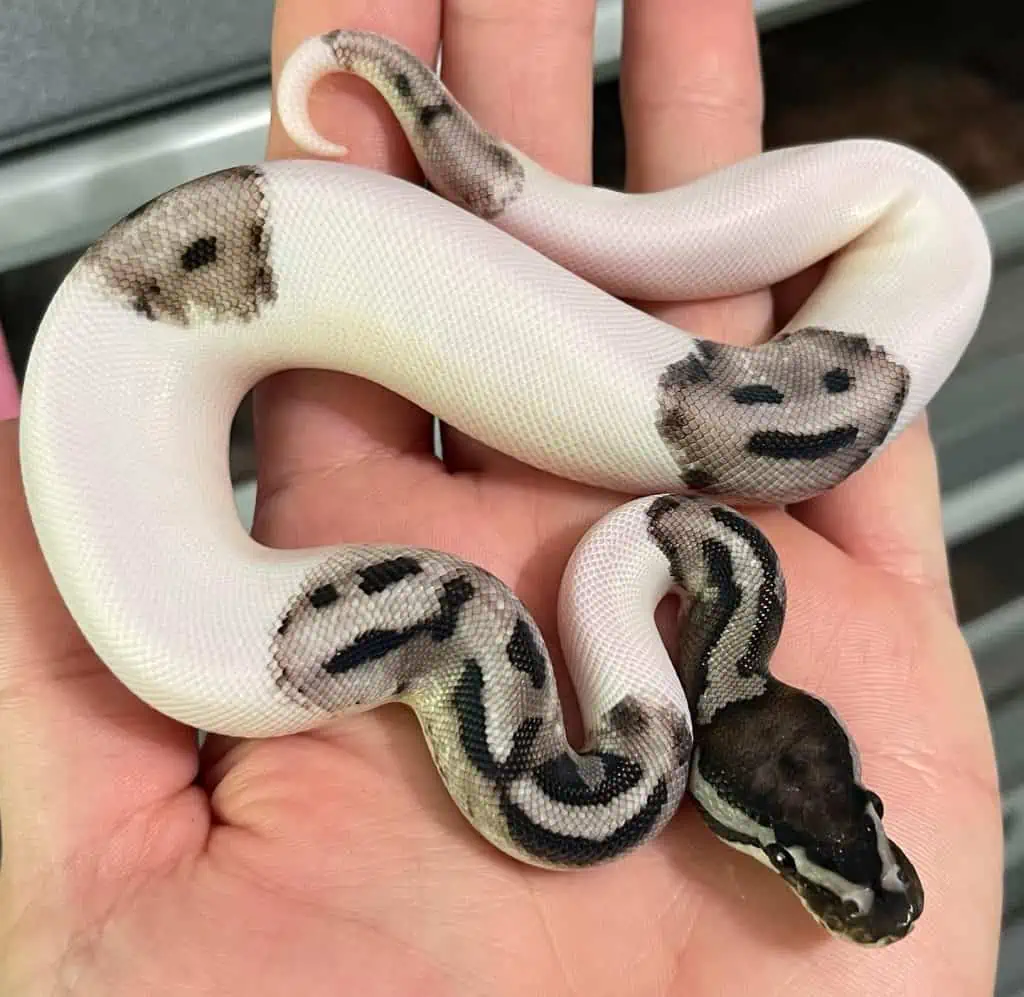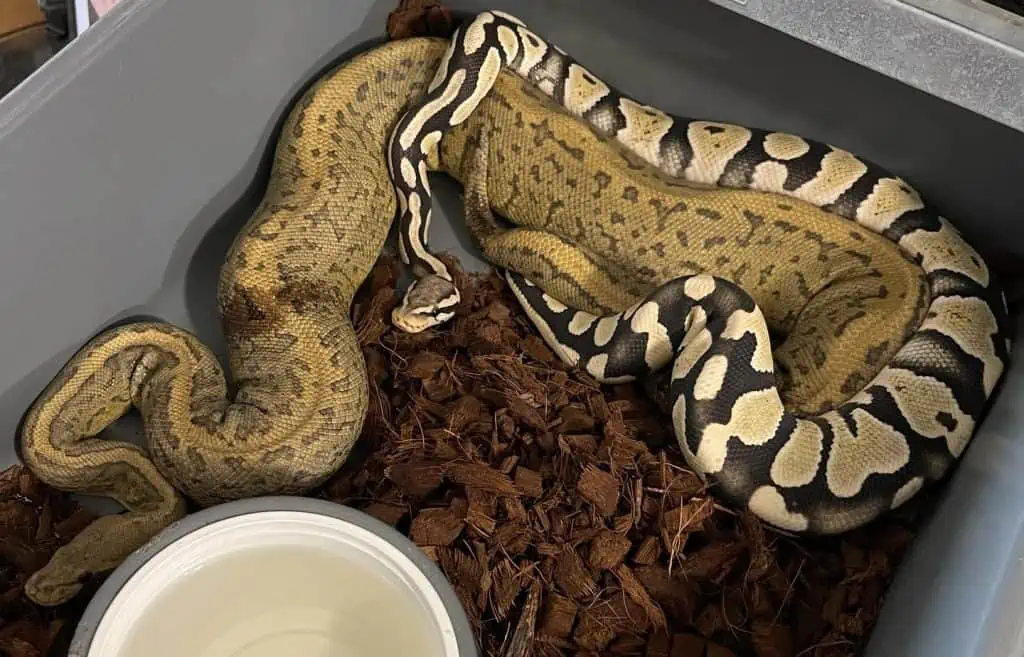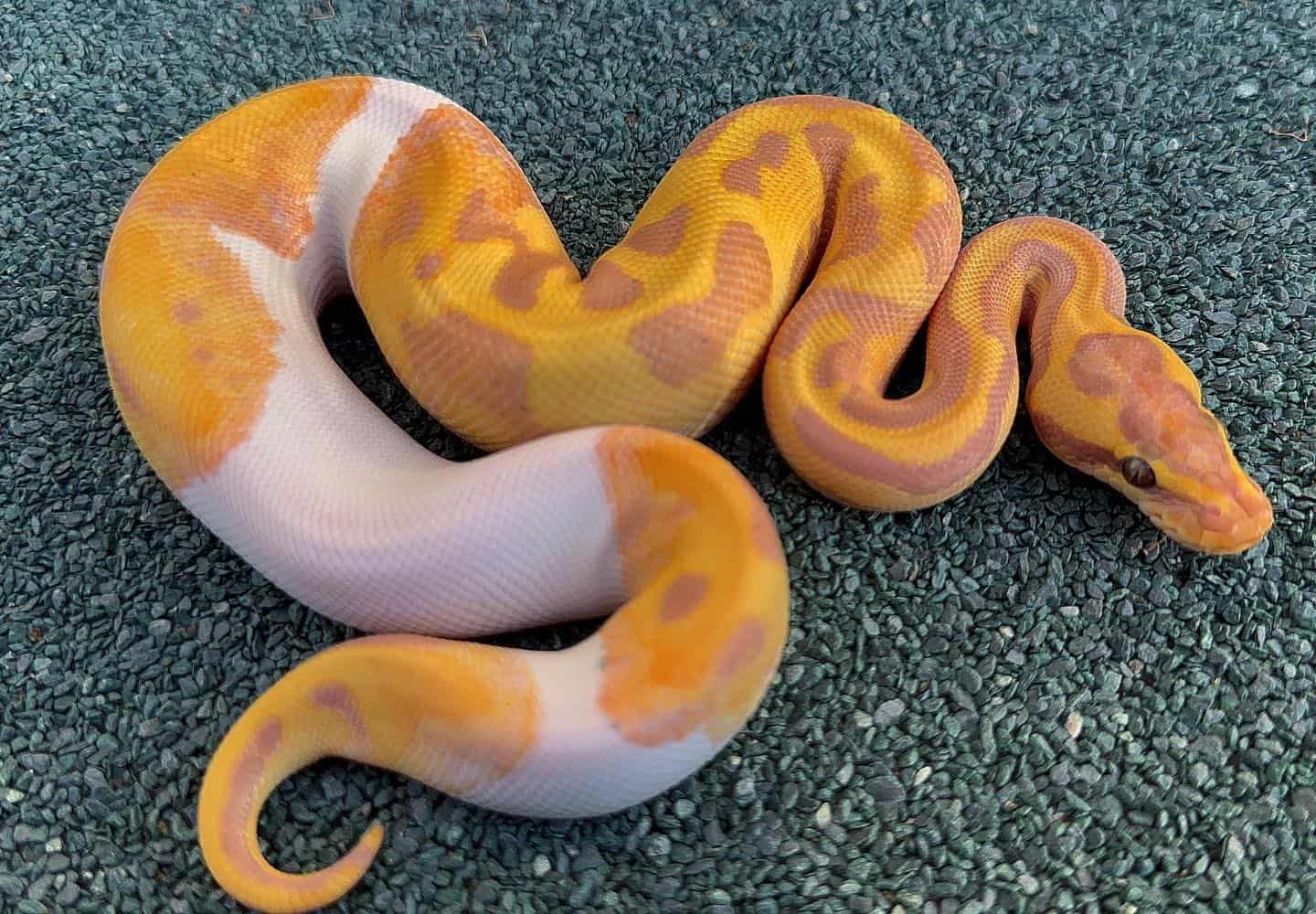Ball pythons are renowned for being one of the biggest pet snakes sold today, yet still, they are easily manageable to keep at home. As a result, they make an excellent choice for beginner snake owners due to their docile temperaments and low-maintenance lifestyle.
They come in an array of colors and sizes. Six factors that determine the size of your ball python are:
- Gender
- Food
- Food quality
- Enclosure size
- Husbandry
- Genetics
With proper care and maintenance of these factors, ball pythons can reach an adult size of 2-6 feet in length and weigh between 1-6 pounds.
This article will explore the ball python’s growth rate, size, and what influencing factors contribute to this species’ development.
Ball Python Growth Rate
Gauging the growth rate of a snake is done by observing its size advancement throughout any given year. Keeping tabs on your reptile’s growth pace will help in ensuring it remains healthy with appropriate weight and dimension.
Ball Python males and females have dissimilar natural growth rates – female snakes grow at nearly 1.5 times that of their male counterparts.
Male Ball Python’s Growth Rate
Male Ball Pythons usually grow 8 inches each year from birth until they reach sexual maturity at age 3. After this, their growth rate begins to slow down and can be as little as 5 or 6 inches per year.
Female Ball Python’s Growth Rate
Female growth is especially rapid in the first four years of life, with near one-foot increments per year. After that point, their height expansion begins to decelerate until it eventually levels off around five years old.
Research has shown that females are born at a higher postnatal rate than males – meaning they begin growing faster within three months of hatching and quickly outpace their male counterparts as they age.

How Large Can a Ball Python Grow?
For many new owners, ball pythons are the perfect pet. At maturity, these snakes can range in size from two to six feet, making them a manageable addition to any household.
Male Ball Python’s Length and Weight
Sexual dimorphism ensures that males are always the smaller gender, reaching their maximum growth at the lower end of the size spectrum. By three years old, they typically measure between 2.5 to 3.5 feet long and weigh anywhere from 2-3 pounds!
Female Ball Python’s Length and Weight
Female Ball Pythons tend to be much larger than males due to their accelerated growth rate. On average, they measure between four and five feet in length, with some specimens reaching a staggering 6 ft!
As for weight, females usually weigh around five or six pounds; however, this largely depends on the size of each individual snake.
How Long Does It Take for a Ball Python To Grow Fully?
Newly-born ball pythons range from 10 to 17 inches in length, but with a faithful feeding regimen and proper care, these reptiles can reach their full size in just five years! However, their growth rate slows down substantially when they hit three years old.
By this age, females grow up to a foot longer than their male counterparts and surpass them in weight by half.
When Do Ball Pythons Reach Sexual Maturity?
Ball Pythons are known for their rapid growth in the first year. Shedding happens regularly throughout, and you can quickly discover how often to feed them accordingly. Most of a Ball Python’s growth occurs during its initial 1-2 years, where it reaches “adulthood,” which is divided into two stages: sub-adult and adult.
Sub-adults have not yet achieved sexual reproductive maturity, while adults are those who have reached that stage.
- Males will reach sexual maturity earlier than females, typically at 18 months. Despite this early growth spurt, they remain the smaller gender of the two.
- On the other hand, it takes females an additional 6 months to grow into adulthood and hit sexual maturation at 24 months old.
Ball Python Growth Chart
Pythons expand at various speeds, which is principally dependent on how much and what type of food they consume. I have crafted a chart to give you a better idea about the rate at which your python will grow with mice or young rats meals.
This estimation should provide insight into why larger prey pieces translate to quicker growth for pythons – bigger appetites mean faster expansion!
| Ball Python’s Age | When Fed Young Rats | When Fed Mice |
| Hatchling | 70-75 grams | 70-75 grams |
| 1 Month | 98-105 grams | 76-80 grams |
| 2 Months | 120-135 grams | 110-120 grams |
| 3 Months | 180-210 grams | 150-180 grams |
| 4 Months | 270-290 grams | 180-210 grams |
| 6 Months | 340-370 grams | 280-310 grams |
| 10 Months | 470- 490 grams | 400-430 grams |
| 12 Months | 540-560 grams | 480-510 grams |
What Are the Factors That Influence Ball Python’s Size?
Ball pythons have a wide range of sizes, and a variety of factors can influence an individual’s size. Understanding the following six factors is essential for owners who want to understand their pet ball python’s size and growth potential.
Gender
One of the most important factors influencing this species’ size is gender. Even when fed exactly what females are given, males develop slower and reach their maximum growth much sooner than females. As such, adult female individuals can be up to two times longer than male specimens!
Genetics
The size of a ball python is largely determined by its genetics. Ball pythons are bred selectively to produce snakes of certain sizes, so the genetic makeup of a particular pet will have a lot to do with its ultimate size.
Husbandry
Proper husbandry also plays an integral role in determining the adult size of your ball python. Unhealthy or overcrowded living conditions can inhibit your Ball Python’s growth and overall health.
It is essential to provide an ideal basking temperature of 88-92°F, as well as create a suitable gradient area since this allows them to digest food and promote regular growth. Providing the right conditions also encourages movement amongst these reptiles while avoiding obesity issues!
Enclosure Size
The size of the enclosure that houses a ball python also significantly impacts its growth and development. Pythons confined in tanks that do not allow them to expand fully will usually remain smaller than their counterparts living in more spacious habitats. A larger tank will provide more space for the python to stretch out, which makes it possible for them to grow bigger and stronger.
A suitable temperature gradient must also be maintained for ball pythons to remain healthy and reach their full potential.
Diet
Ball Pythons are known to be picky eaters, making it complicated to get them accustomed to new food. Snakes are not recommended to starve for extended periods, yet overfeeding is also a severe issue. On the other hand, underfeeding your snake will likely cause stunted growth and, in extreme cases, death. To ensure their steady growth and healthiness, I recommend feeding juvenile pythons every 1-2 weeks and adults once or twice monthly.
Quality of Food
The quality of food you feed your snake is essential for optimal growth and development. If you do not provide your pet with the right type of food, it may grow too slowly or not grow at all.
A wide range of aspects can affect your snake’s growth rate and body condition. So, regularly weigh your snake as well as closely monitor their girth to make sure that they are within the recommended guidelines.

How Do I Weigh a Ball Python?
Monitoring the weight of your ball python is a key element in providing it with proper care. More so, I urge pet parents to weigh them to track their health and growth history regularly.
To achieve this, procure a digital scale that can precisely measure a range of 50-6000 grams, along with a plinth measuring at least six inches in length and width for accurate weighing of your snake.
Before you weigh your snake, make sure it’s calm and secure in your hands. If possible, try to distract or comfort them before you place them on the scale. To measure your snake:
- Set the container on the scale and reset it to zero so that its weight doesn’t factor into the overall measurement.
- Now place the snake on the scale and make sure it’s secure. Once it’s in place, take a reading and record it somewhere.
- If your snake has an affinity for exploring, you can use a Tupperware container to contain it. When measuring the weight of your snake with the dish, make sure that you cover it securely with its lid.
- After taking the reading, take the snake off of the scale and return it to its enclosure.
Importance of Weighing Ball Python
As your ball python grows, the amount of food it can take in will also increase. This is why you must pay attention to its weight and adjust its feeding accordingly, furthermore:
- It helps you track its health and development.
- This enables you to spot any drastic weight changes, which could indicate a potential health issue or some other behavioral problem that needs to be addressed.
- It also helps you determine when your snake needs more food or is becoming overweight.
How To Know If Your Ball Python Is Getting Obese?
The heartbreaking reality is that obesity in captive Ball Pythons is a pervasive issue and can be mistaken for rapid growth. I advise pet parents to look for the following tell-tale signs for early diagnosis of this condition:
- Visible skin between scales
- Wrinkling or folding scales
- Skin that is very soft to the touch
- Round body shape
- Sluggish and slow movements
- Difficulty shedding skin
- Unable to stretch out completely when lying down
- A large fatty bulge before the tail
- The body may appear segmented
If you notice any of these signs, you must immediately act for your python’s health.
How To Avoid Obesity?
To protect your python from obesity:
- Ensure you provide them with the appropriate amount of nutrition through a healthy and balanced diet catered to their age.
- Additionally, offer the food in moderation and monitor it to ensure that the ball python is not overeating and becoming overweight.
- Furthermore, guarantee that they are provided with an adequate space in which to move and exercise.
If a ball python is found to be overweight, steps should be taken to reduce its calorie intake, such as reducing the number of feedings per week or swapping out higher-calorie prey items for lower ones.
Final Thoughts
Ball pythons can grow to incredibly large sizes. The best way to determine the size of your ball python is to measure it and weigh it. This way, you can be sure that your pet is healthy and the proper size for its age. By taking good care of your ball python and providing it with safe husbandry conditions and plenty of food, you can ensure that it reaches its full potential in terms of size and weight.
So, how big is your ball python? Do you have any tips or tricks for keeping them at their optimal size and weight? Share with us in the comments!
Featured Photo Courtesy of Palumbo’s Pythons & Boas


